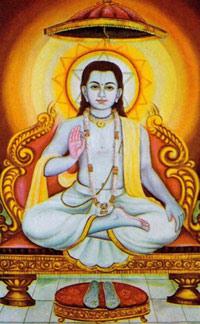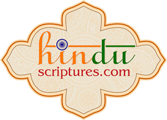SHRI NIMBARKACHARYA
Contents
. Introduction
. Childhood and Early Life
. Philosophy
. Nimbarka’s five methods to salvation
. Nimbarka Sampradaya
. Works of Nimbarkacharya
. Disciple Tradition
Introduction

Shri Nimbarkacharya was a great saint who lived in the 13th century and propagated the Vaishnava theology of Dvaitadvaita which means duality in unity.
Vaishnavism is focussed on followers of Vishnu and they worship Vishnu and his ten incarnations. They are generally dualistic, non ascetic, monastic and devoted to chanting and meditation. Their practice of Bhakti Yoga is based on scriptural texts like Puranas, Vedas and Upanishads. They follow a process of initiation or diksha given by a Guru under whom they are trained to understand and follow Vaishnava practices.
Nimbarka is believed to be the incarnation of the Sudarshana Chakra or discus of Lord Vishnu. It is believed that as a devotee of the Lord, the Sudarshan Chakra begged the Lord to bless him with a human life so that he could not only serve the ‘Archa Vigraha’ of the Lord but also revel in his divine pastimes and savour the pain of separation from his Lord. It is said that the Lord moved by his plea granted his request.
There are four kinds of Avataras-
1. Purna or full like Lord Krishna, Lord Rama etc.
2. Kala or not all full like Matsya, Hamsa Varaha etc.
3. Amsa or part like Jada Bharata, NaraNarayana etc
4. Amsamsa(Part of the part) like Shankara, Ramanuja, Nimbarka etc.
The Bhagavad Puran states that the Manas putras of Lord Brahma the Kumaras asked Brahma how it was possible to achieve liberation when the mind always clung to sense objects and the same gets imprinted through lifetimes as Vasanas or tendencies. Brahma was unable to give a fitting reply hence he meditated on Shri Hari who appeared symbolically as Hamsa(the swan is supposed to have the ability to separate milk from water implying that true knowledge was separated from the unreal). This was later communicated to Narada and from him to Shri Nimbarkacharya. He was said to be the embodiment of love, piety, kindness, mercy and other divine qualities. That is why the Sampradaya is also referred to as Kumara Sampradaya or Hamsa Sampradaya.
Childhood and Early Life
It is said that the Lord asked his Sudarshana Chakra to take birth on Earth to show millions of people steeped in ignorance the Vaishnava Dharma way of spreading knowledge through the path of Bhakti. Nimbarka was born to a great ascetic named Aruna Muni and Jayati Devi at Vaiduryapattinam(now known as Moongipattinam) on the banks of the Godavari in Andhra Pradesh and was named Niyamananda. Soon he grew up and they performed his thread ceremony and sent him to a school run by Rushis for the study of the scriptures. When he was in his teens, Lord Brahma came to the ashram disguised as a sage. The sun was about to set. He asked Niyamananda’s mother for food to eat but she had nothing to give him and his father too was not at home. Not knowing what to do she remained silent. Sanyasis do not take their meals after sunset so the sage began to leave. But Niyamananda said he would bring some fruits etc and till then the sun would not set. He placed his Sudarshan Chakra on the neem tree and provided a glimpse of the sun even after actual sunset. The Sanyasi who was none other than Brahma gave him the name Nimbarka (Nim-Neem tree, Arka-Surya or the sun). Symbolically the name ‘Nimbarka’ also denotes the birth of a great soul who with his luminence and splendour would remove the neem like bitterness of the materially submerged human souls.
It is said that by the age of 16, he had mastered all scriptural texts. With the permission of his parents he embarked on his search for a Guru. He reached Govardhan in Mathura, Uttar Pradesh and began practising penance. Sage Narada blessed him with the knowledge of Dvaitadvaita or unity in duality. Niyamananda begged him to accept him as his disciple so Narada gave him initiation according to Vaishnava rites and instructed him on the eighteen syllabled Gopala Mantra of the Gopala Tapani Upanishad. He instructed him to continue his penance with that Mantra. He also gave him a Shaligram deity to perform worship. Niyamananda did as instructed and was blessed when the Lord revealed himself as Radha-Krishna. He then recollected his former glory as the Sudarshana Chakra of the Lord.
Gopala Tapani Upanishad- There are four Tapani Upanishads-Narasimha, Gopala, Tripura and Rama of which the Gopala Tapani is most popular. It forms one of the 108 Upanishads. It gives the significance of Krishna and the spiritual practices that need to be undertaken to realise this aspect. The object of love is Krishna while Radha is his primary Shakti exemplifying the means to unlock the mystery of life and love by her principle of love, self giving and sacrifice. It is the most important Upanishad for those following the path of Krishna Bhakti or devotion to Krishna. The eighteen syllabled Gopal Mantra is said to primarily contain names of Krishna like Govinda, Gopijanavallabha etc and it fosters sharanagati or self surrender. Continuous chanting leads to a particular relationship with the divine name. Then the efficacy of the mantra is realised leading to Ultimate Knowledge. That is the reason why mantra diksha is of primary importance in this Sampradaya.
Philosophy
Nimbarka’s philosophy is known as Dvaitadvaita(duality and non duality simultaneously). According to this philosophy there are three categories of existence, Chit(Jiva or individual soul), Achit(Jagat or the world) and Ishvara(Brahman or a personal God). Chit and Achit are different from Ishvara as they have attributes(gunas) and capacities(Svabhaava) which are different from those of Ishvara. Ishvara is independent and exists by himself but Chit and Achit depend on him for their existence. At the same time they are different from him because they cannot exist independently of him. Thus Nimbarka emphasised both difference and non difference just like between the sun and its rays. Thus according to him there are three entities Brahman or Ishvara which is the controller, the chit which is the enjoyer and the achit which is the object enjoyed. This led to the establishment of the Nimbarka Sampradaya.
Nimbarka identifies the Supreme Brahman with Krishna who is endowed with all auspicious qualities and is free from ignorance, passion, attachment and egoism. He has four forms or Vyuhas namely Sankarshana, Pradyumna, Vasudeva and Anirudha. He is free from all defects. He has a divine body and is full of love, beauty, charm and sweetness.
Nimbarka’s five methods to Salvation
Five methods were-
1.Karma(righteous action)-Performing action as per one’s Varna or caste and ashrama or station in life conscientiously and in the proper spirit gives rise to knowledge which is a means of salvation. There are three types of karma-a)Nithya Karma which is action performed everyday including religious observances b)Naimitik karma which are actions performed due to customs such as performance of last rites and observance of fasts and pilgrimages and lastly c)Kamya Karma which is action performed to gain some temporary benefit. The first two karmas are indispensable to human life and cannot be renounced. But the third has to be given up as it entraps the soul in the vicious cycle of birth and death. Performing actions without desire for the fruit (Nishkama Karma) and offering all fruits at the feet of the Divine is the right approach and this selfless performance of activities is the first step in the path towards salvation.
2.Vidya(knowledge)- Knowledge by study of scriptures and reflecting, contemplating and meditating on its deeper meanings leads to Shama(ability to exercise restraint on the mind), dama(ability to exercise restraint on the sense organs of action and perception), Tyaga(renunciation of worldly pleasures), Titiksha(intense dedication to God), Uparati(non attachment and disinterest in worldly pleasures) and Shraddha(devotion). These purge the mind of all its impurities.
3.Dhyana(Upasana or meditation)-There are three types of meditation, First meditation on the Lord as the inner controller of the perceivable or as one’s self, secondly meditation on the Lord as the inner controller or the non perceivable and thirdly meditation on the Lord himself as different from the perceivable and non perceivable. This sadhana can only be performed by those who are qualified to perform this Upasana with Yajnopavitam.
4.Prapatti(Surrender to the lord with devotion)-The devotee has to surrender to the lord Radha-Krushna and this is open to all irrespective of class, creed or gender. It is Apara or Sadhana Bhakti or devotion through rules and regulations. This leads to Para Bhakti the highest devotion which has Madhurya rasa or is sweet as honey.
5.Gurupasatti(Devotion and surrender to the Guru)-After being accepted by a Guru, the devotee has to follow his instructions with diligence and perseverance. Surrender and devotion at the feet of the Guru enables the devotee to cross the ocean of Samsara just as a boatman takes the boat safely to the shore.
Nimbarka Sampradaya
It is one of the Vaishnava Sampradayas and is based on the Dvaitadvaita philosophy. It was considered to be founded by the four Manas Putras of Brahma namely Sanaka, Sanatkumara, Sanatana and Sanandana. Obtaining the grace of Lord Krushn, they began spreading the teachings of Vaishnavism. The Sage Narada who was their younger brother was also their disciple. He initiated Nimbarka into Vaishnavism and it consists of worship of Radha-Krushna with Radha being personified as the inseparable part of Krushna. This is called Yugala Vigraha Upasana. It is said that this was the first time that Radha and Krushna were being worshipped together by anyone other than the Gopis of Vrindavan. Krushna represents the personification of God and Radha his adorable and joyous attribute. Nimbarkacharya said that a devotee may worship the Lord as a servant, friend, parent, spouse, ascetic or a lover. In other words the devotee can adore God according to the emotion that surges through him and inspires him. The Sampradaya has now continued unbroken till date. Brindavan, Nandgram, Govardhan and Barsana are the chief kshetras or holy lands of the followers of Nimbarkacharya. Their foremost duty is circumambulation or parikrama of the 168 miles of Brij Bhumi.
Works of Nimbarkacharya
Nimbarkacharya wrote the following books-
1. Vedanta Parijat Saurabh- A Bhashya on the Brahma sutras on his Dvaitadvaita Vedanta philosophy.
2. Sadachar Prakash- A Treatise on Karma Kanda
3. Rahasya Shodasi- an explanation of the Shree Gopala Mantra in the form of verses.
4. Prapanna Kalpa Valli- an explanation of the Shri Mukunda Mantra in the form of verses.
5. Prapatti Chintamani- A treatise pertaining to supreme refuge.
6. Prata Smarana Stotram- A devotional hymn
7. Dasa Shloki or KamaDhenu- The ten nectarine verses
8. Savisesh Nirvisesh Shri Krishna Stavam
9. A Commentary on the Bhagavad Gita
Disciple Tradition
Not much is known about the year of demise or any other information about the death of Nimbarkacharya. The disciple tradition of Shri Nimbarkacharya continues till this day. As the mission spread and branches began to spring up in different places, there was a need for more than one successor so the 35th leader reformed the tradition and anointed twelve of his senior disciples to lead missions throughout the land. The 48th and current leader of the entire Nimbarka Sampradaya is Sriji Maharaj who is based in Nimbarka Tirtha , Rajasthan and he worships the Shaligram deity known as Shri Sarveshvara. He oversees maintenance of temples, schools, monasteries, hospitals, environmental projects, hrines and arranges religious conventions, medical camps etc.
